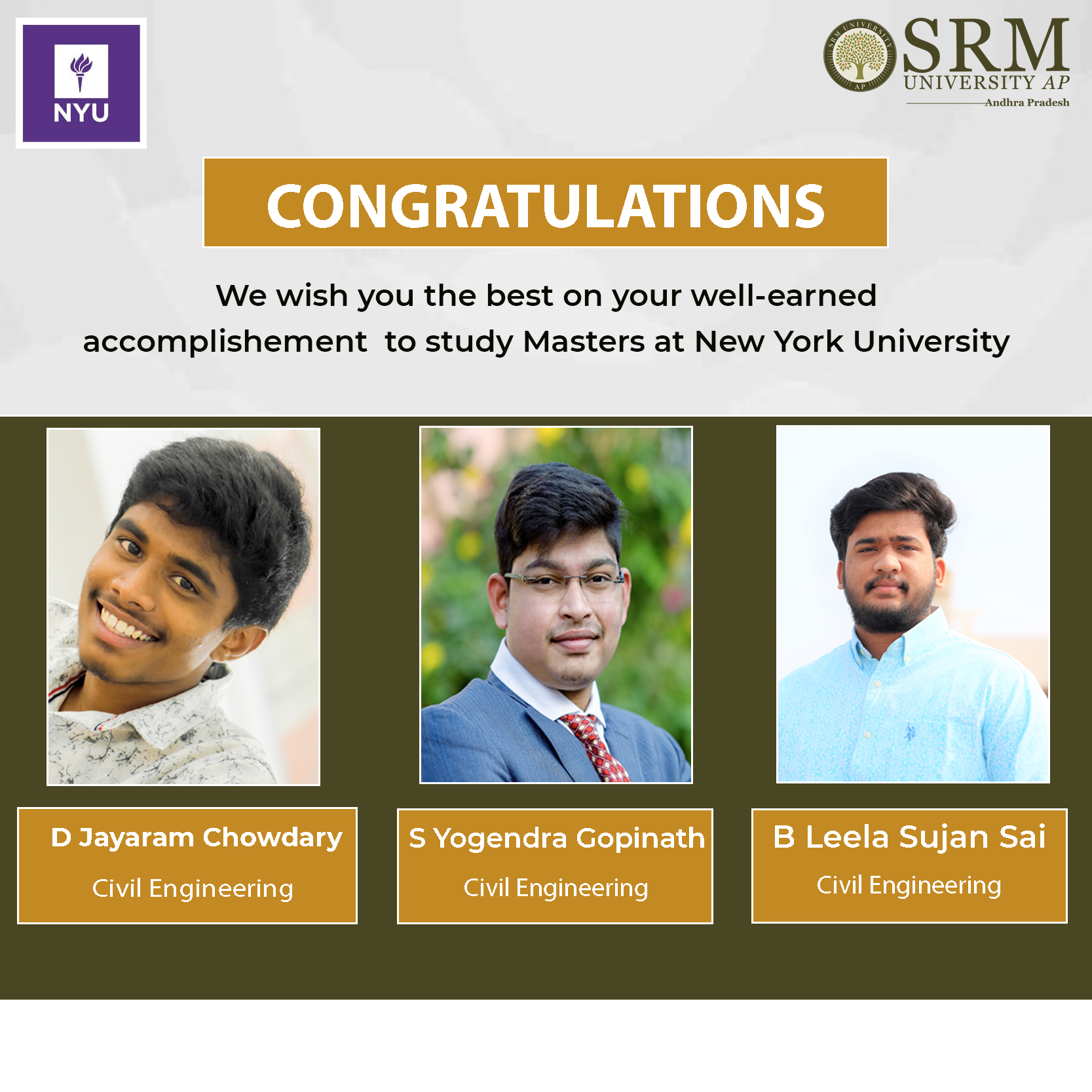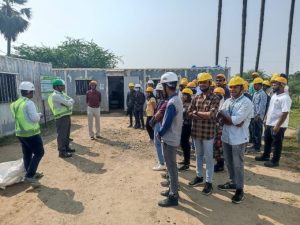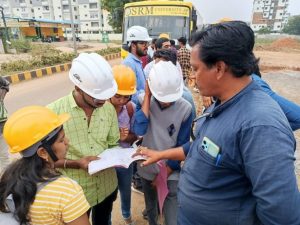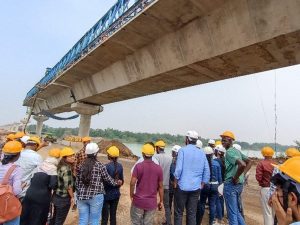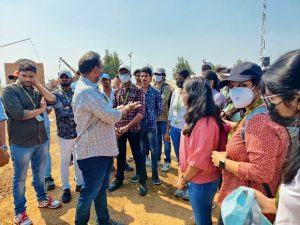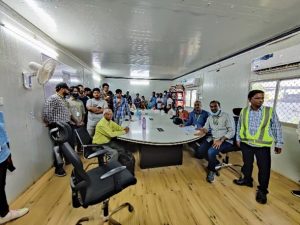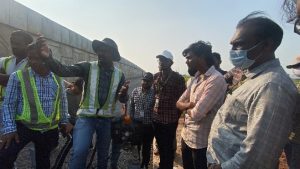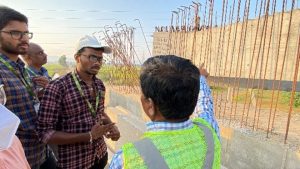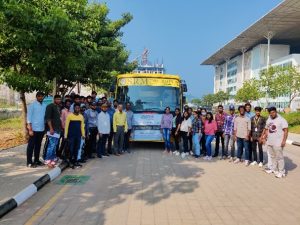Civil engineering student secures admission to multiple universities abroad
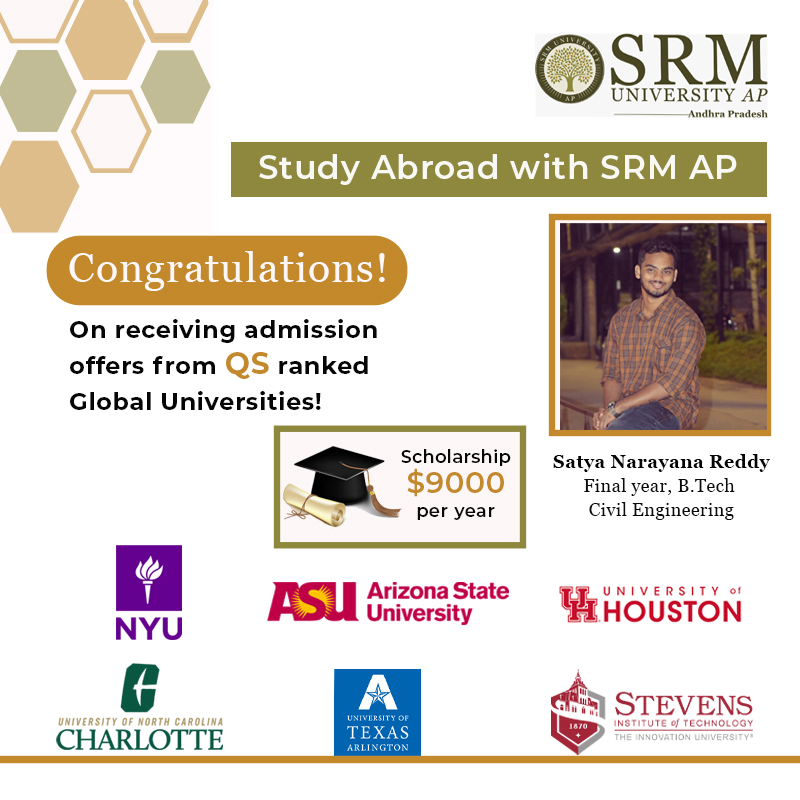 In recent years, the number of Indian students enrolling in colleges abroad has increased. The competition to secure a seat in a world-class university also increases with the number of students aspiring for higher education. The office of International Relations and Higher Studies at SRM University-AP ensures that our students are admitted to QS ranked universities, not just one but many. Satya Narayana Reddy Kovvuri, final year student from the Department of Civil Engineering has received admission offers from New York University, Stevens Institute of Technology, University of North Carolina Charlotte, University of Houston, Arizona State University, and the University of Texas Arlington.
In recent years, the number of Indian students enrolling in colleges abroad has increased. The competition to secure a seat in a world-class university also increases with the number of students aspiring for higher education. The office of International Relations and Higher Studies at SRM University-AP ensures that our students are admitted to QS ranked universities, not just one but many. Satya Narayana Reddy Kovvuri, final year student from the Department of Civil Engineering has received admission offers from New York University, Stevens Institute of Technology, University of North Carolina Charlotte, University of Houston, Arizona State University, and the University of Texas Arlington.
Read this exclusive interview with Satya Narayana and get inspired!
How do you feel about the admission offers and the scholarship?
I applied to 9 universities, and I was not confident about the admissions because of the high intake. The first university I got the offer from was Stevens institute of technology. Then I gained confidence that I could make it into my desired university. Later I was overwhelmed by the admits that I secured and even a scholarship to NYU. Among the 9 Universities I applied to, I received admission offers from Stevens Institute of Technology, University of North Carolina Charlotte, New York University, University of Houston, Arizona State University and the University of Texas Arlington. I’m also eagerly waiting to hear from Kent State University, Clemson University and the University of Washington.
Selection process of universities you are admitted to
The Selection process is almost the same for all the universities I applied to. After submitting the application, the documents go for the department (of the selected course) review, and the selection criteria will be based on:
- Good GRE and English Proficiency test score(IELTS/TOEFL/DUOLINGO)
- A good CGPA with no backlogs.
- An efficient SOP that describes your qualities, achievements and skills.
- Strong LORs from professors.
- Research Papers / Publications(if any)
Within two months, the universities will inform us of the decision and the details of the scholarship if we are qualified. I have received a scholarship of $9000 per year from New York University, which is ranked 42 in the QS global ranking.
About the course that you have decided to enrol in
The course that I have decided to pursue is an MS in Construction Management. As I am keenly interested in the construction sector and my bachelor’s degree is in Civil Engineering, I decided to gain more knowledge and experience in the same field. The opportunity to study Construction Management course is my dream come true.
Support from SRM AP (Faculty, mentors etc.)
Dr Uma Maheshwar Arepalli, Assistant Professor in the Department of Civil Engineering is specialised in Transportation Engineering. He provided me with a few insights about courses and the colleges which are suitable for my specialisation. It helped me clear my confusion while I was applying for universities. Dr Bhagath Singh, Head of the Civil Engineering department, also guided me in this process. I followed his instructions on how to apply to universities abroad. The Academic affairs department also helped me by providing transcripts and certificates as soon as I approached them so that there is no delay in my application process.
Your message to junior batches
I advise my juniors to start the process as early as possible. Score high in the GRE (310 -325) and IELTS (6.5 – 8)tests. Search for the universities that provide the best coursework for your desired branch. Also, keep in mind the states you choose in the US provide job opportunities after you complete graduation. Lastly, choose the better states by thinking about living expenses and weather conditions. Check for the requirements of your targetted universities beforehand and draft an excellent personal statement. Submit the applications before priority deadlines as it is crucial to secure scholarships. Check for regular updates in the mail and also in the university application portal.
- Published in CIVIL NEWS, Departmental News, International Relations, IR-News, News
Journey of civil engineering students to New York University
By earning a ticket to NYU Tandon School of Engineering for the Master’s programme, Students of Civil Engineering; Jayaram Chowdary Dasari, S Yogendra Gopinath and Leela Sujan Sai Borra have added one more feather in the department’s cap. It is a matter of joy and pride for the Department of Civil Engineering and the university as more and more students are getting admitted to international universities. Harnessing the true potential of each student and preparing them for a bigger world have always been the primary focus of SRM University-AP.
They are groomed from a very early stage to reflect on their educational objectives and initiate the appropriate action. “I had started my preparation way ahead and cleared the GRE and IELTS tests, then I consulted my Professors Dr Bhagath sir, Dr Narasimha Murthy sir and Dr Uma Maheswar Rao sir for guidance and with their help, I shortlisted the universities and the best programmes which can fulfil my future goals,” said Yogendra.
“We will never forget our faculty members for their immense support in helping us find the right universities, and also for the initiatives taken by the department such as conducting webinars to educate students about the application procedure for higher studies.” Borra and Jayaram also marked their gratitude to the department.
The Office of International Relations at the university has also played a crucial part in their achievement as it walked them through the right procedures for an overseas application. “I shall forever be thankful to Dr Shweta ma’am for her valuable guidance on drafting an incredible SoP” added Yogendra.
An enriching learning environment with exposure to global educational practices rendered at SRM University-AP will foster the right academic spirit in students and enable them to move ahead with better clarity of purpose. Also, training imparted by the expert faculty will help them gather deeper insights and transform themselves into professionals in their respective fields.
- Published in CIVIL NEWS, Departmental News, International Relations, IR-News, News, Students Achievements
DST-SERB international research fellowship for Dr Raviteja
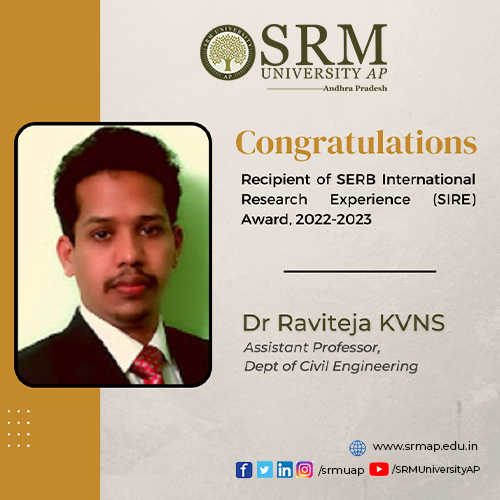
SERB International Research Experience (SIRE) is a coveted opportunity for passionate researchers to collaborate with leading institutions across the globe for high-end research training in frontier areas of Science and Technology. Dr Raviteja from the Department of Civil Engineering has earned this opportunity through his resourceful project titled “Sustainable Ash based Geosynthetic Clay Liners for MSW Landfills”. The work proposes a sustainable design of solid waste landfill liners using industrial by-products like fly ash.
Municipal solid waste (MSW) landfills need to be lined at the bottom to avoid contaminant transport. The conveyance of noxious pollutants from the landfill to the natural ground can be restricted using natural or synthetic barriers. In general, natural materials like clays/bentonites in combination with geomembranes (GMB) are used in liners. However, to increase the strength properties and reduce the compressibility characteristics, bentonites are often mixed with sand. With the increased cost and scarcity of sand, there is a renewed interest among the researchers to identify an alternative material to replace sand proportion in compacted GCLs in MSW landfills. Among several materials, fly ash is proved to be a potential substitute for sand in landfill liners.
This experience will serve as an excellent opportunity to work at one of the world-renowned, state-of-the-art geoenvironmental laboratories at the University of Illinois Chicago. “I feel fortunate to collaborate with Prof. Krishna Reddy, one of the eminent researchers in the geoenvironmental research fraternity. My research at UIC would be on developing sustainable ash-based geosynthetic clay liners for MSW landfills. I also wish to pursue recent advances in this area and identify a framework for my future research”, said Dr Raviteja. The project will help him establish strong research collaborations with experts in the geotechnical labs at other US universities. He can also make field visits to identify the practical problems and direct his research toward the real-field applicability.
With an enriching research exposure at UIC, he will be able to formulate innovative and advanced research problems to enhance the visibility and applicability of his project. Presenting this work at various conferences and seminars will also attract various potential collaborations and MoU with other universities abroad. According to him, “this is a less explored domain that will immensely benefit research scholars and undergraduate students to invent new possibilities and scopes in the future”.
- Published in CIVIL NEWS, Departmental News, Faculty Achievements, News, Research News
Systematic bibliographic research on eutrophic-ecological models

The Department of Civil Engineering is delighted to announce that Dr Siddhant Dash has published a paper titled “Systematic bibliographic research on eutrophication-based ecological modelling of aquatic ecosystems through the lens of science mapping” in the journal “Ecological Modelling” having an Impact Factor of 3.512. This research was conducted in collaboration with Prof Ajay S Kalamdhad from IIT Guwahati.

This research is a systematic approach on reviewing the published literature on eutrophic-ecological models developed worldwide and the methods associated with them. This provides critical insights into the status of the research domain, thereby providing a direction for the practising and future researchers to undertake a research career in this domain. It offers a more comprehensive and holistic approach to the critical review of the published literature, providing a deeper understanding to the researchers regarding the existing practices of developing eutrophication-based ecological models and the prospects lying ahead. His future research plans include understanding carbon and nutrient dynamics within an aquatic ecosystem.
Abstract of the Research
When water bodies receive surplus nutrients, especially nitrates and phosphates, these nutrients stimulate excessive plant growth (eutrophication), including harmful algal blooms, leading to oxygen depletion, decreased biodiversity, changes in species composition and dominance, and degradation of water quality. Although there are natural causes, much of the eutrophication today results from inadequately treated wastewater and agricultural runoffs. Population pressure, urbanization and industrialization contribute a considerable amount of waste, which alters the physio-chemical quality of water that eventually upsets the biotic components of the aquatic system. It is important to note that though pollution has been a significant factor in degrading the quality of aquatic ecosystems, the lack of management and global awareness regarding the protection and conservation of water bodies worldwide cannot be neglected. Hence, there lies an inherent sense of responsibility to restore the aquatic ecosystems to their natural state. Numerous techniques/treatment options are available for varying conditions, such as climatic factors, socio-economic factors, and so on. However, before ascertaining a treatment alternative to curb eutrophication levels, understanding the dynamics of any independent aquatic ecosystem is of prime importance. This necessitates a reliable model, which can provide information regarding the physical processes and dynamic occurrences in the eutrophic water bodies. Ecological modelling refers to the formation of dynamic and complex relationships between the organisms found in the ecosystem and the surrounding. It attempts to unravel the effects of certain relationships in the ecosystem that are not so apparent at first glance. The present study provides a scientific investigation of a detailed review of the published works in the domain of eutrophication-based ecological modelling till the year 2020. The first step was the scientometric studies, which were followed by a qualitative assessment wherein the current trends in research were discussed. This was followed by identifying the critical gaps in research to provide future direction.
Fig. 1. Ecological modelling process
Fig. 2. Description of the three-step literature review process employed in this research
- Published in CIVIL NEWS, Departmental News, News, Research News
Dr Uma Maheswar to work on an overseas-funded project
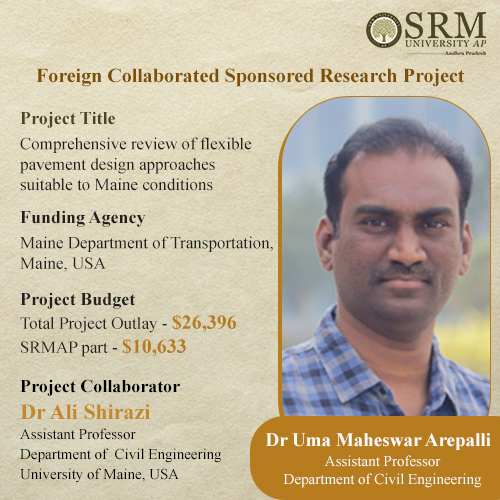
Yet another moment of pride and honour for SRM University-AP as Dr Uma Maheswar Arepalli, Assistant Professor, Department of Civil Engineering in collaboration with Dr Ali Shirazi, Assistant Professor, Department of Civil Engineering, University of Maine, USA received a research project award from the Maine Department of Transportation, Maine, USA. The project titled “Comprehensive review of flexible pavement design approaches suitable to Maine conditions” received a total project outlay of $26,396 (Rs. 21.12 Lakhs).
This is the first of its kind project in India that receives funding directly from the foreign (United States) entity unlike the typical Department of Science & Technology (DST) International Bilateral Joint Project Schemes. This 8-month-long project will review the various existing flexible pavement design approaches in the USA and will provide recommendations to the Department of Transportation on a suitable design approach conducive to the conditions of Maine.
The outcome of the project will help the Department of Transportation to decide on a suitable pavement design approach that enhances the performance of pavements in Maine. The project engenders an opportunity for two under-graduate students of SRM University-AP to work as paid interns and receive international exposure in their prospective research areas. It also involves the scope for industry translatory research.
- Published in CIVIL NEWS, Departmental News, News, Research News
Dr Raviteja KVNS Received the Best Paper Award at TRACE 2022
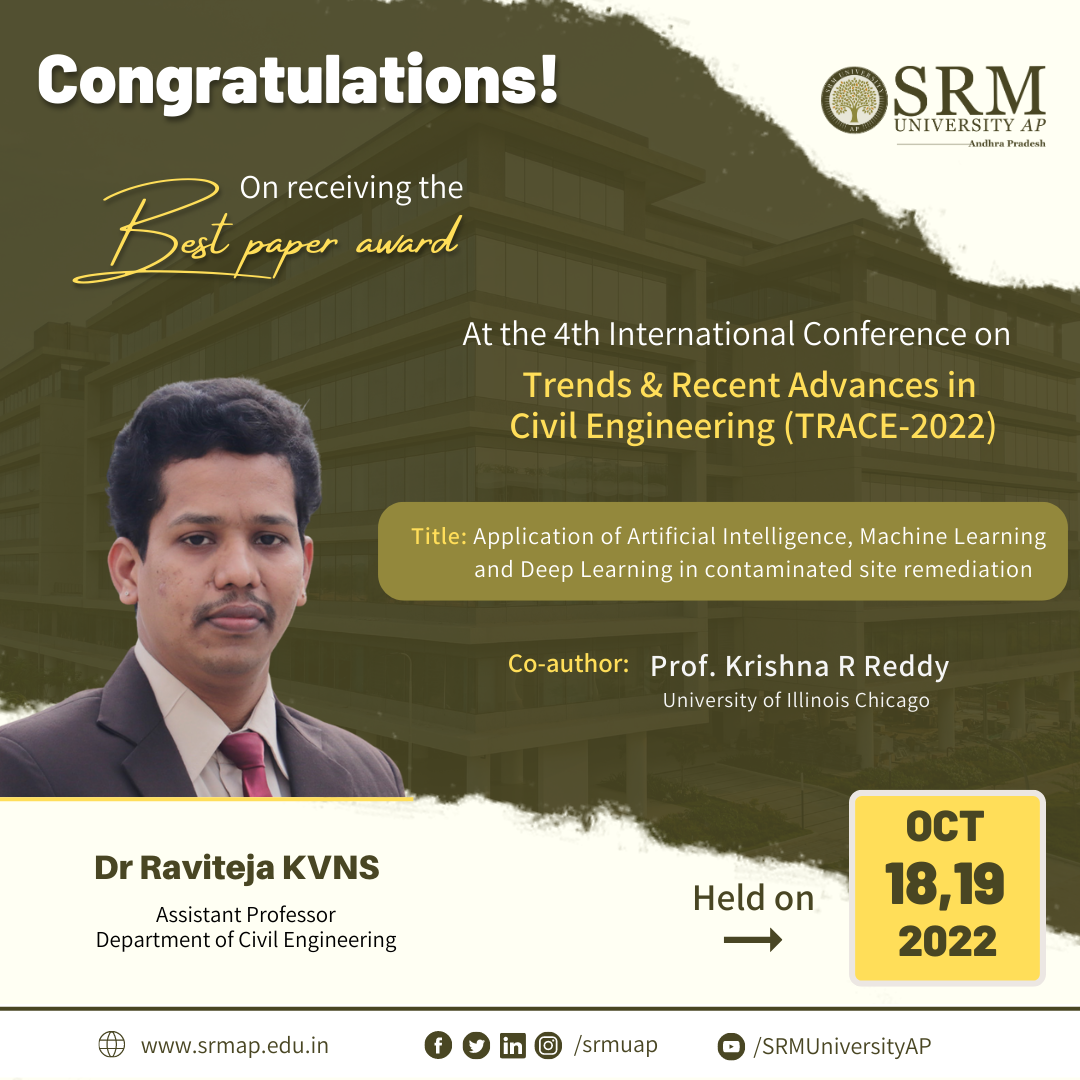 Soil and groundwater contamination is closely interlinked with human society because of its direct impact on population health and socioeconomic activities. The design and implementation of site remediation can be expensive, time-consuming, and may require much human effort. Emerging technologies such as Artificial Intelligence, Machine Learning, and Deep Learning have the potential to make site remediation cost-effective with reduced human effort.
Soil and groundwater contamination is closely interlinked with human society because of its direct impact on population health and socioeconomic activities. The design and implementation of site remediation can be expensive, time-consuming, and may require much human effort. Emerging technologies such as Artificial Intelligence, Machine Learning, and Deep Learning have the potential to make site remediation cost-effective with reduced human effort.
Assistant Professor Dr Raviteja KVNS, Department of Civil Engineering, has received the Best Paper Award at the Fourth International Conference on Trends and Recent Advances in Civil Engineering (TRACE) 2022 for his paper Application of artificial intelligence, machine learning and deep learning in contaminated site remediation. The conference was held at Amity University, Uttar Pradesh, on October 18 and 19, 2022. His research reports the applications of AI and ML in contaminated site remediation.
Dr Raviteja’s future research plan includes studying potential applications of various AI, ML and DL techniques for Geotechnical and Geo-environmental design and testing applications so as to reduce the labours of physical and repetitive testing and associated human effort. This further improves precision as well as aids in decision-making. He has collaborated with Prof. Krishna R Reddy, University of Illinois Chicago, for this research work.
Abstract
Soil and groundwater contamination is caused by improper waste disposal practices and accidental spills, posing a threat to public health and the environment. It is imperative to assess and remediate these contaminated sites to protect public health and the environment as well as to assure sustainable development. Site remediation is inherently complex due to the many variables involved, such as contamination chemistry, fate and transport, geology, and hydrogeology. The selection of remediation method also depends on the contaminant type and distribution and subsurface soil and groundwater conditions. Depending on the type of remediation method, many systems and operating variables can affect the remedial efficiency. The design and implementation of site remediation can be expensive, time-consuming, and may require much human effort. Emerging technologies such as Artificial Intelligence, Machine Learning, and Deep Learning have the potential to make site remediation cost-effective with reduced human effort. This study provides a brief overview of these emerging technologies and presents case studies demonstrating how these technologies can help contaminated site remediation decisions.
- Published in CIVIL NEWS, Departmental News, Faculty Achievements, News, Research News
Employing Information Entropy in Determining the Water Body’s Health Status
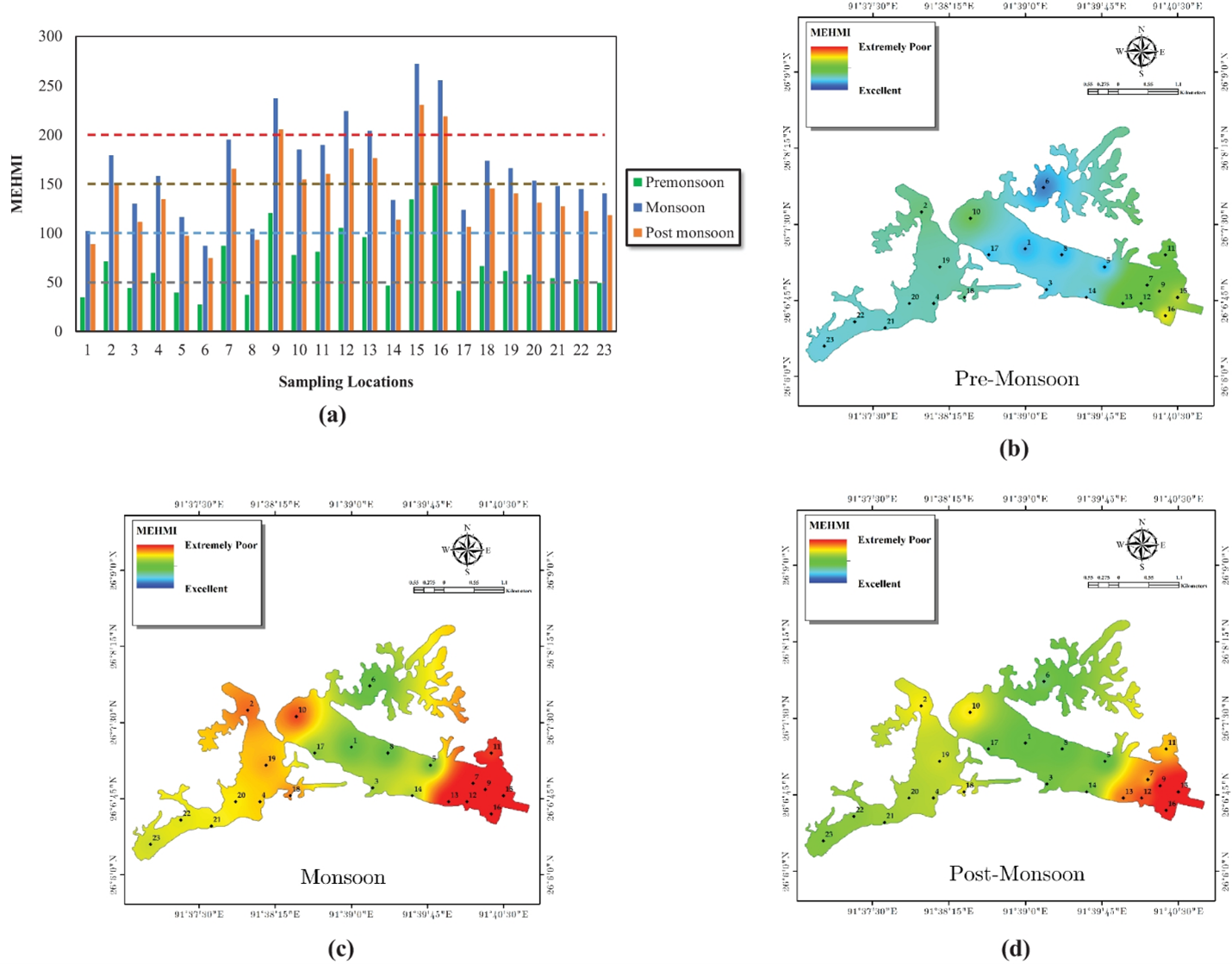 The global population is changing drastically, increasing at an alarming rate of more than 80 million per year. This growing population has led to enormous pressure on land-use patterns and, to a greater extent, the natural ecosystems, especially water bodies. The water bodies are getting depleted considerably, and their quality is significantly deteriorating. Assistant Professor Dr Siddhanth Dash from the Department of Civil Engineering has published the paper Development of function-specific indices for assessing water quality based on the proposed modifications of the expected conflicts on existing information entropy weights in the journal Environmental Monitoring and Assessment with an impact factor of 3.307. He has collaborated with Dr Ajay S Kalamdhad, a Professor at the Department of Civil Engineering, IIT Guwahati, for the research.
The global population is changing drastically, increasing at an alarming rate of more than 80 million per year. This growing population has led to enormous pressure on land-use patterns and, to a greater extent, the natural ecosystems, especially water bodies. The water bodies are getting depleted considerably, and their quality is significantly deteriorating. Assistant Professor Dr Siddhanth Dash from the Department of Civil Engineering has published the paper Development of function-specific indices for assessing water quality based on the proposed modifications of the expected conflicts on existing information entropy weights in the journal Environmental Monitoring and Assessment with an impact factor of 3.307. He has collaborated with Dr Ajay S Kalamdhad, a Professor at the Department of Civil Engineering, IIT Guwahati, for the research.
Explanation in Layperson’s Terms
Waterbody contamination is attributed to a various number of reasons: primarily anthropogenic contamination, such as extensive industrial (small as well as large-scale) discharges, leaching of chemical fertilisers from the agricultural grounds, the release of toxic chemicals such as heavy metals and pesticides, and discharge of untreated sewage water from residential complexes (primary constituents being nutrients such as N, P, and K and pathogens). These depletions of the natural water systems have affected the entire aquatic ecosystem. Indexing tools have proved to be the most significant of all the techniques developed. Water quality indices (WQIs) are mathematical representations of a particular body’s water quality, providing a singular numeric denomination reflecting its health status. Specific indices are unique indices which provide information regarding the overall anthropogenic contamination and are broadly target-specific. Over the years and extensive studies carried out worldwide, while multivariate statistics have proved its reliability, the existing approach of using entropy weights suffers from various ambiguities.
Dr Dash’s study addresses vital issues relating to the existing use of entropy weights in WQIs, thus proposing a novel approach to employing information entropy in determining the water body’s health status.
 Practical Implementation and Social Implication of the Research
Practical Implementation and Social Implication of the Research
Water quality assessment remains paramount when providing safe and potable water as per the United Nations Sustainable Development Goals (SDGs). This study’s results would pave the way for a more reliable and time-conserving manner of assessing water quality and a broader context and health status of a water body that will help protect and preserve different water bodies globally. The present study will also benefit the researchers and policymakers in making sustainable decisions toward restoring water bodies and preventing them from plausible future deterioration.
Working on sustainable and effective treatment techniques to remediate emerging contaminants in aquatic ecosystems is the future research plan of Dr Dash.
Abstract
Water serves numerous purposes besides drinking, such as irrigation and industrial usage. Most water quality indices developed have primarily focused on drinking water quality. However, assessing other functionalities of water bodies is also equally essential. The present study proposes a novel technique to measure water quality for two highly specific water use, i.e., assessing heavy metal contamination and irrigation suitability. The ambiguities in the current practice of entropy weights were identified, and a novel method was proposed, considering a three-dimensional approach instead of the conventional two-dimensional procedure. Weights to different parameters were assigned based on the probability estimates obtained from the frequency of observed values within acceptable limits. The proposed method’s reliability, correctness, and applicability were tested using Deepor Beel’s water quality dataset. Results were highly consistent with the experimental values and correlated well with other established methods. The efficacy of the method was determined by employing sensitivity analyses. Both indices showed high reliability and correctness, as no single parameter was found to be highly sensitive compared to others. Therefore, the proposed methodology proved to be the most reasonable, incorporating all the factors required for a reliable water quality monitoring program.
Citation of the Article
Dash, S., & Kalamdhad, A. S. (2022). Development of function-specific indices for assessing water quality based on the proposed modifications of the expected conflicts on existing information entropy weights. Environmental Monitoring and Assessment, 194(12), 1-17.
- Published in CIVIL NEWS, Departmental News, News, Research News
Industry Visit for Hands-on Exposure
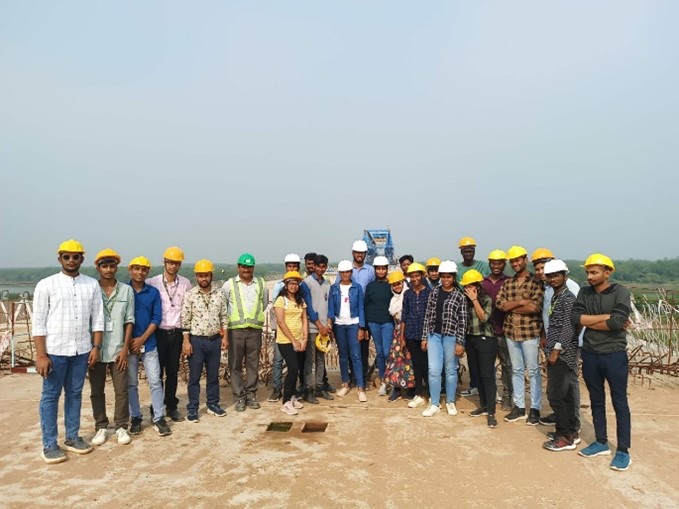
The Department of Civil Engineering of SRM University-AP conducted the second industrial visit for the Civil Engineering students of all semesters on November 30, 2022.
Details of the industrial site
An 18-kilometre stretch bridge over the Krishna River in the Chinakakani-Gollapudi highway is under construction jointly by the Adani group and Navayuga Engineering Company Limited. Hands-on practical insight was provided by experienced site Engineers on the topic of the post-tensioned precast bridge and the launching arrangement of each precast segment using advanced technological equipment. Students were also exposed to the different units of the site (i.e., the Safety class was delivered by the site officials, the Concrete batching plant, Quality control laboratories, and the Casting yard of the precast units).
Coordinating faculty: Dr Nishant Sharma and Dr Arijit Saha
- Published in CIVIL NEWS, Departmental News, News
Industrial Visit to MEIL
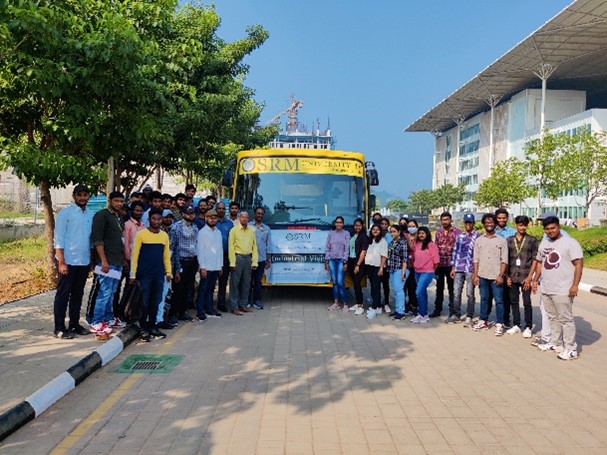
The Department of Civil Engineering has organised an industrial visit to Megha Engineering & Infrastructure Limited (MEIL) for engineering students to harbour them with the practical skillsets demanded by profession. The field visit was guided by senior engineers working on respective sites and co-ordinated by the faculty.
Project: Six-Laning of Vijayawada Bypass from Chinna Autupalli (Design Ch. 0.000) to Gollapudi (Design Ch. 30.000) Section of NH-16
Construction Company: Megha Engineering & Infrastructures Limited (MEIL)
Visit Highlights:
- Safety training by MEIL
- Quality Control Lab tour
- Soil, Aggregate, Bitumen, and Cement Concrete Testing
- Quality Control Aspects
- Batching Plant visit
- WMM and Concrete batching plants
- Site Tour
- Earthworks, Embankment, and WMM Construction
Coordinating faculty: Dr A Uma Maheswar
- Published in CIVIL NEWS, Departmental News, News
Academic Trio Secures Second Prize at Aakaar Symposium
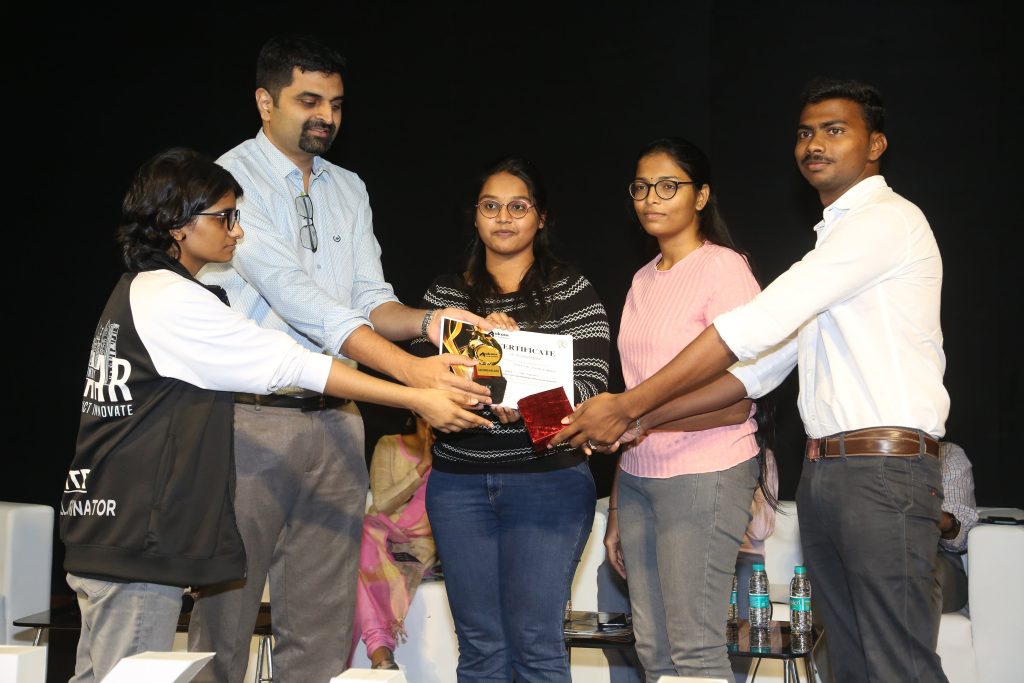
The students of SRM University-AP are nurtured in a conducive educational ecosystem that moulds them into competent candidates ensuring research and academic success at national and international frontiers. The Department of Civil Engineering proudly congratulates Tanoogna Mallarapu, Jonnalagadda Cheritha and Gade Venkata Reddy, Final year BTech students for securing the second prize in the Paper presentation contest at the prestigious Aakaar Symposium held by The Department of Civil Engineering, IIT Bombay on March 17 and 18, 2023. The trio presented their paper titled “Study of alternative flexible pavement design approaches suitable for Maine conditions” which was part of the students’ paid internship on an overseas (USA) research project funded by the Maine Department of Transportation, USA. A total of 47 groups participated in the contest from various domains of civil engineering from all over India. The academic cohort bagged the position of runners-up under the guidance and mentorship of the faculty advisor, Dr Uma Maheswar Arepalli, Assistant Professor, SRM Univeristy-AP.
About the Symposium
Aakaar is an annual symposium organized by the Department of Civil Engineering at IIT Bombay. The event comprises workshops, lecture series, panel discussions, industrial talks, exhibitions, and other activities. The festival also includes the Seventh International Civil Engineering Symposium (ICES), which aims to encourage young research enthusiasts to engage in rigorous research in civil engineering. ICES includes poster presentations, 3-minute thesis talks, city planning, and paper presentations. The symposium offers young and promising students enthusiastic about research the opportunity to present their work in front of experienced professors, civil engineering leaders, and industrialists.
The team had the incredible opportunity to meet renowned academicians and industrialists and learn about various projects in the civil engineering domain. Their work was highly praised by the judges with Dr Dharmaveer, Associate Professor, Civil Engineering Dept., IIT Bombay commenting that, “I enjoyed their presentation. I like their exposure to new tools and techniques, exploring new terms, learning, and understanding, which made them worthy.”
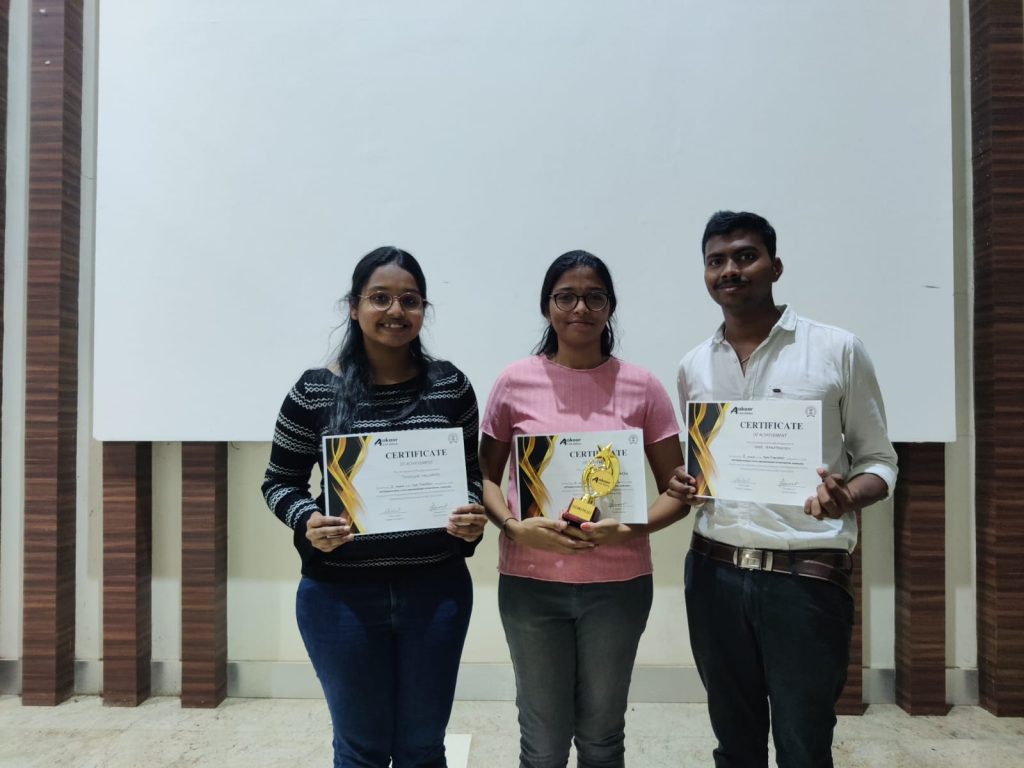
Tanoogna from the team stated her elevation in acquiring this success. “From the outset, I was motivated to participate in the competition and showcase my skills. Our advisor, Dr Uma Maheswar was always available to answer our questions, provide feedback on our work, and offer valuable insights that helped us refine our approach. His mentorship has played an integral role in our success, and we could not have accomplished this without his assistance. We are grateful for this opportunity and the platform that IIT Bombay provided us. It has been a fantastic journey, and I look forward to participating in more competitions and pushing my limits further,” said the young scholar.
Cheritha also expressed her gratitude towards her team’s accomplishment and the valuable experience the symposium had provided. “We were able to show case our work and was able to present it effectively and secured 2nd place in the category of paper presentation. Participating in this event is an incredible experience for me to gain knowledge. I am very grateful for my advisor and my teammates Tanoogna and Venkata Reddy for their hard work towards the accomplishment of the project and for being there in difficult situations.”
Venkat also commented that the event was beneficial in gaining knowledge and to present the project. The students thanked their mentor, Dr Uma Maheswar for the opportunities he had provided and his constant encouragement to strive for excellence.
Dr Uma Maheswar, Assistant Professor, Department of Civil Engineering, SRM University-AP also voiced delight in the incredible performance of his students. “From the beginning, I had the feeling that the topic has the potential to win this competition. But this team of students has made it a reality with their excellent technical and soft skills. It was a moment of immense pride and happiness for us in the civil engineering department when our students won the contest at a prestigious platform like IITB. Heartful congratulations to Tanoogna, Cheritha, and Venkat. I wish them the best of luck in their future career endeavours.”
Abstract of the Paper
AASHTOWare Pavement Mechanistic-Empirical Design (PMED) has been introduced to overcome the limitations of the AASHTO 1993 pavement design approach in the United States. However, due to the data requirements and work involved with accurate local calibration of PMED performance models, PMED seems challenging from a benefit-cost standpoint, especially for the states with low traffic volumes and limited resources. This study aims to understand the current flexible pavement design practices in the United States and recommend an alternative design approach for a state department of transportation. The methodology included an online survey with practitioners, a literature review, and a comparative analysis of selected alternative design approaches. Two approaches were chosen as an alternative design approach based on the online survey results, interviews, and literature review. One is updating layer coefficients for AASHTO 1993, and the second is developing its mechanistic-empirical (M-E) based pavement design approach for Maine. A layered elastic analysis using winJULEA or similar combined with standard performance empirical equations was considered a proposed M-E design tool for preliminary analysis. A sensitivity analysis using the range of design input values for Maine conditions and validation with a historical project database is planned. The presentation will discuss this study’s findings and the final recommendations derived from the comparative analysis.
- Published in CIVIL NEWS, Departmental News, News, Students Achievements


